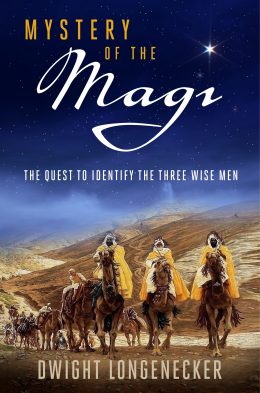Who Were the Wise Men?
BOOK PICK: Mystery of the Magi

MYSTERY OF THE MAGI
The Quest to Identify the Three Wise Men
By Dwight Longenecker
Regnery History, 2017
320 pages, $25 (hardcover), $10 (Kindle)
To order: regnery.com
Is there any historical basis to the story of the Three Wise Men found in Matthew 2:1-13?
Modern scholarship would say No, and move on to a discussion of its legendary quality, use of familiar motifs and rhetorical purposes, while the rest of us are left saying, “Wait a minute …”
That’s what Father Dwight Longenecker — pastor, author and blogger — said, and Mystery of the Magi is his answer. Father Longenecker has written a corking fine read, full of gripping history and insightful speculation. It’s unlikely to convince the skeptics, and some of its later conclusions are purely well-informed fancy, but it opens a fascinating avenue for reconsidering the Magi, their journey and their gifts.
Among modern biblical scholars, Ulrich Luz is typical in dismissing the historicity of the material. Over the course of three fat volumes of skillful commentary on Matthew, he barely spends a page evaluating the historical aspects of the passage before concluding that the “story contains no historical core.”
His reasons for discounting it — the lack of a parallel in Luke, the astronomical issues and even the question of why Herod didn’t send a spy with the Magi (!) — are remarkably insufficient, but, sadly, typical of contemporary biblical scholarship.
The story is unique to Matthew, perhaps reflecting a source of Aramaic material unavailable to Luke or Mark. It has become an integral part of the Christmas season, although some of its most familiar details are later embellishments.
The Bible never mentions a long journey by camels, the number of Wise Men isn’t specified, they don’t arrive at the manger by a house, and the names Balthazar, Melchior, and Caspar date to centuries later.
Tradition made them Persian Magi (magicians, astrologers or, more generally, wise men), most likely because of Herodotus’ use of the Greek magoi for Zoroastrian priests.

Father Longenecker, however, lays out an intriguing alternative. In his telling, the Wise Men were not Persians, but Arabs. This tallies with the claims of Justin Martyr in Dialogue With Trypho, where he repeatedly asserts that “Magi came from Arabia.” After convincingly arguing that the embattled Persian priestly class would be unlikely to leave the Parthian court of Phraates IV to travel to Judea during the reign of Herod, Father Longenecker offers an intriguing substitute.
Deep in the red rock city of Petra, the Nabateans built a small kingdom that was a trading hub for the region. Jews, Parthians, Persians, Edomites, Greeks and Romans were all drawn to this well-watered city of wonders.
The Nabateans had deep ancestral ties with the Abrahamic tribes. Furthermore, they were involved in political intrigue between Herod and Roman Emperor Augustus.
The central chapters of Mystery of the Magi lay out the regional history and politics, all leading to the book’s main claims: The Magi were Nabateans. They rode swift horses on the Nabatean trade route from Petra to the port at Gaza, a trip that would have only taken a few days.
They visited Jerusalem on a diplomatic mission from King Aretas IV to see who might be the heir of Herod, also taking note of astrological signs that indicated the potential appearance of the Messiah.
They followed these signs and information from Herod’s court to do homage to Jesus with valuable gifts of gold, frankincense and myrrh from Petra.
By the final chapters, Father Longenecker begins wondering about a possible Magian school of refugee Nabatean wise men and Essenes from Qumran (!) that would form the foundation of the future Christian community in Damascus. At that point, readers are advised to just enjoy the ride. These portions are engrossing, but, as the author admits, purely speculative.
The appeal of Mystery of the Magi is the way it sifts Scripture and history from pious legend and then follows the text itself, as if Matthew meant what he wrote. Father Longenecker is never dull, and even when he’s engaging in speculation, the case is well made, consistently engaging and persuasive. It’s an engrossing bit of historical detection and arrives just in time for readers to accompany the Magi on their journey to Christmas.
writes about archaeology and Church history.
- Keywords:
- father dwight longenecker
- magi














